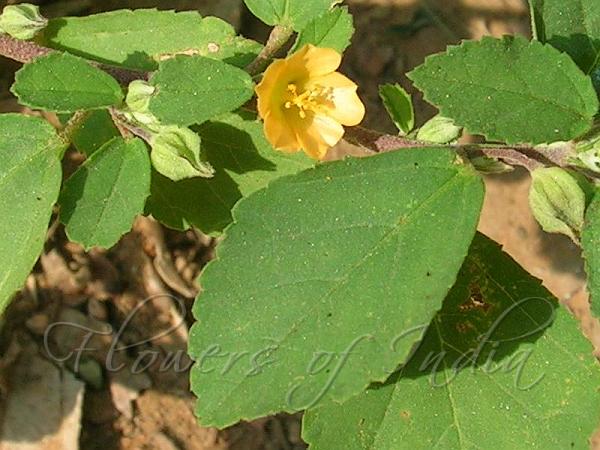|
| Rhombic-Leaf Sida |
|

|

| File size | 112007 |
| Original date | 10/13/05 11:16 AM |
| Resolution | 2048 x 1536 |
| Flash | Flash did not fire, auto |
| Focal length | 8.0mm |
| Exposure time | 1/207s |
| Aperture | 5.5 |
| Focus Distance | |
| Metering Mode | Partial |
| Camera make | NIKON |
| Camera model | E3700 |
| Sensor type |
|
|
|
Photo: |
Botanical name: Sida rhombifolia Family: Malvaceae (Mallow family)
Rhombic-Leaf Sida is a weed very common in India and Sri Lanka in the dry country.
A summer annual with yellow
flowers and very small spines at the base of each leaf and branch. This plant
most often occurs as a weed of peanuts, cotton, and soybeans.
Leaves are arranged alternately along the stem, approximately 1-4.5 x 0.6-2 cm,
with stalks that are less than 1/3 the length of the leaves. Leaves
are widest at or above the middle and taper toward the leaf bases (rhombic)
The upper half of the leaves have toothed or serrated margins while the
remainder of the leaves are untoothed.
Flowers occur singly on flower stalks 1-2.5 cm. Flowers consist of 5 yellow
petals that are 4 to 8 mm long.
The seedlings with 2 heart-shaped cotyledons, the small spines that occur at
the base of each leaf petiole, and the 'rhombic' leaves are all
characteristics that help in the identification of Rhombic-Leaf Sida.
Medicinal uses: Rhombic-Leaf Sida has significant medicinal applications for which it
is cultivated throughout India. The pounded leaves are used to relieve
swelling, the fruits are used to relieve headache, the mucilage is used
as an emollient. Its root is used as an anticrotalic, a serum is prepared
against the venom of rattlesnakes and black widow spiders.
Rhombic-Leaf Sida has significant medicinal applications for which it
is cultivated throughout India. The pounded leaves are used to relieve
swelling, the fruits are used to relieve headache, the mucilage is used
as an emollient. Its root is used as an anticrotalic, a serum is prepared
against the venom of rattlesnakes and black widow spiders.
Medicinal uses:
 Rhombic-Leaf Sida has significant medicinal applications for which it
is cultivated throughout India. The pounded leaves are used to relieve
swelling, the fruits are used to relieve headache, the mucilage is used
as an emollient. Its root is used as an anticrotalic, a serum is prepared
against the venom of rattlesnakes and black widow spiders.
Rhombic-Leaf Sida has significant medicinal applications for which it
is cultivated throughout India. The pounded leaves are used to relieve
swelling, the fruits are used to relieve headache, the mucilage is used
as an emollient. Its root is used as an anticrotalic, a serum is prepared
against the venom of rattlesnakes and black widow spiders.
| Identification credit: R.K. Nimai Singh | Photographed in Delhi & Manipur. |
• Is this flower misidentified? If yes,